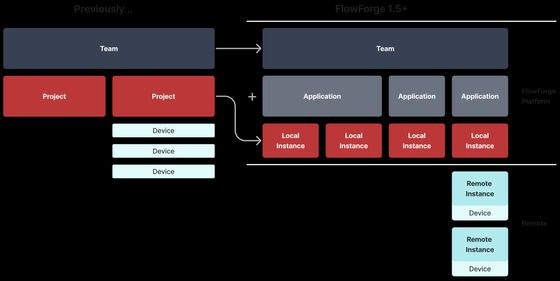Terminology Changes
Applications, Instances & Devices - the new way forward for FlowFuse

As a new product in the market, we constantly have to make choices on how to name things. Naming things is hard! As you name a thing, say "Project", it might be suitable now, but the product evolves, and may outgrow the name such that it doesn’t fit anymore.
We are at this point with FlowFuse, and want to walk you through what we have planned, and why we are changing a couple of things.
Enter the "Application"
In FlowFuse 1.5, we have introduced a new concept called an Application.
An Application will allow you to organize multiple Node-RED instances into a single managed group.
As of the 1.5 release, an Application can still only have a single Node-RED instance, but in future releases, Applications will allow for multiple Node-RED instances and will allow us to implement capabilities such as DevOps Pipelines and High Availability.
"Projects" to "Instances"
Until now, 'Project' encapsulated both the Node-RED instance that was running in FlowFuse, and the associated devices (remote instances), settings and environment variables. It was an overloaded term, and it caused confusion with our users.
To simplify things, and to adhere more to the terminology familiar with the Node-RED community, we are renaming Projects to Instances.
An Instance is a customized version of Node-RED that includes various FlowFuse plugins to integrate it with the FlowFuse platform. It can also be used to manage the environment variables used in your Node-RED flows.
Instances can either be:
- Local - An instance of Node-RED running in FlowFuse.
- Remote - An instance of Node-RED, managed by FlowFuse, running on a Device.
In future releases, environment variables will also be able to be stored at the Application level, and shared across multiple Node-RED Instances.
Devices
FlowFuse can also be used to manage remote Node-RED instances. This is typically useful when you have a number of remote devices that are required to run the same Node-RED instance, and may have variation in configuration or environment variables for example.
Devices are registered to an Instance, and can be configured to run Snapshots of the Instance running in FlowFuse.
To accomplish this remote management capability, the FlowFuse Device Agent needs to be installed on each device. Devices are registered with a Team, and then the appropriate device(s) are assigned to a Node-RED instance that should be deployed to the device(s). When the Node-RED instance is ready for deployment, a user creates a snapshot of the instance and marks it as a target snapshot for the device.
We hope these changes will simplify the FlowFuse terminology for our users and allow us to grow the FlowFuse platform. If you have any feedback or thoughts, please do reach out to us.
About the Author
Joe Pavitt
Joe has been working with Node-RED for nearly 10 years, having worked with Nick O'Leary at IBM as a Master Inventor, and been one of the early developers working on the original Node-RED Dashboard. Since joining FlowFuse in 2022, Joe has become the lead for the FlowFuse Dashboard (Dashboard 2.0), created the Node-RED Academy and leads design and front-end development for FlowFuse.
Table of Contents
Related Articles:
- FlowFuse 2.25: Interacting with MCP Resources in FlowFuse Expert, Improved Update Scheduling, and lots of UI improvements!
- FlowFuse 2.24: FlowFuse Expert in the Node-RED Editor, Scheduled Updates, Simpler Edge Device Addition, Store and Forward Blueprint, and what's next!
- FlowFuse 2.23: MCP and ONNX nodes, FlowFuse AI Expert on the homepage, Application-level Permission Control, FlowFuse Assistant for Self-Hosted, and more!
- FlowFuse 2.22: AI Copilot for node editing, FlowFuse Broker schema autodetection, Improved Snapshots Interface, eCharts enablement, and FlowFuse Dashboard Updates
- FlowFuse 2.21: AI-Assisted SQL, Low-Code Custom Nodes, and Remote Instance Performance Insights